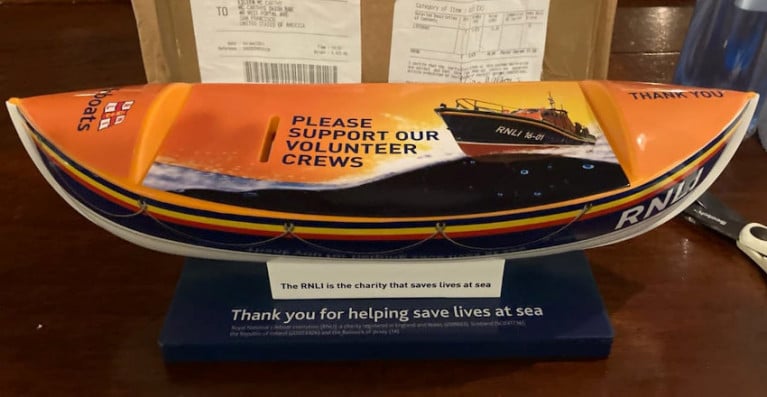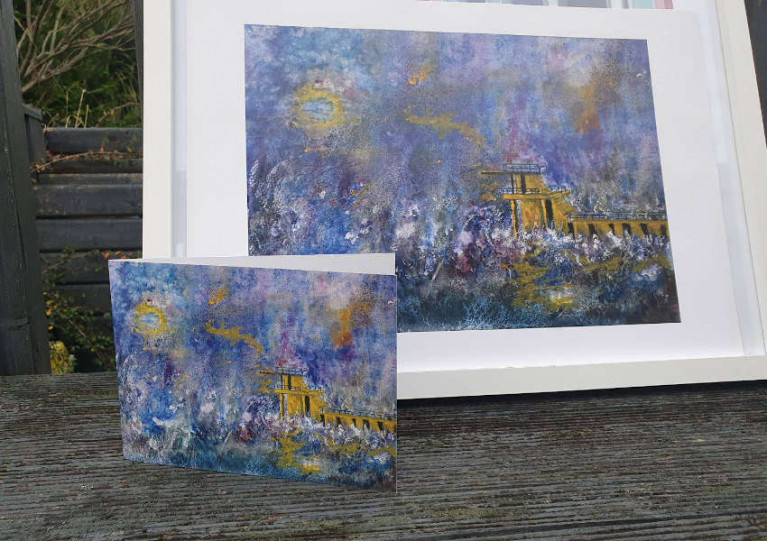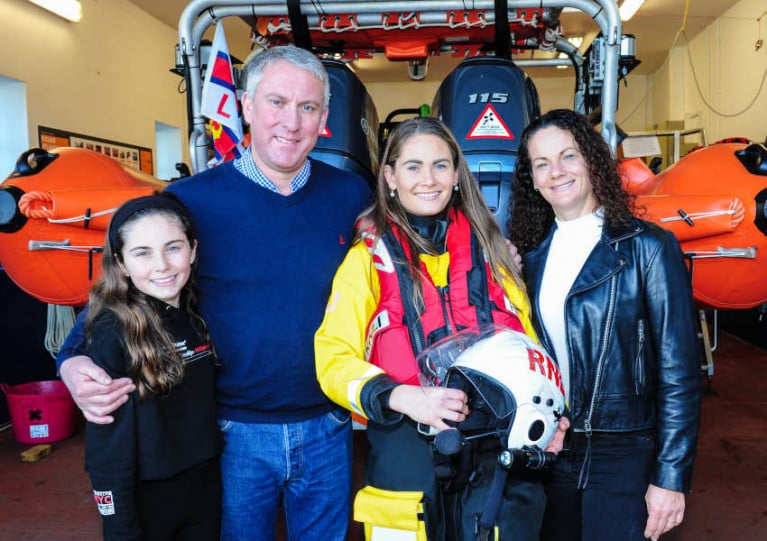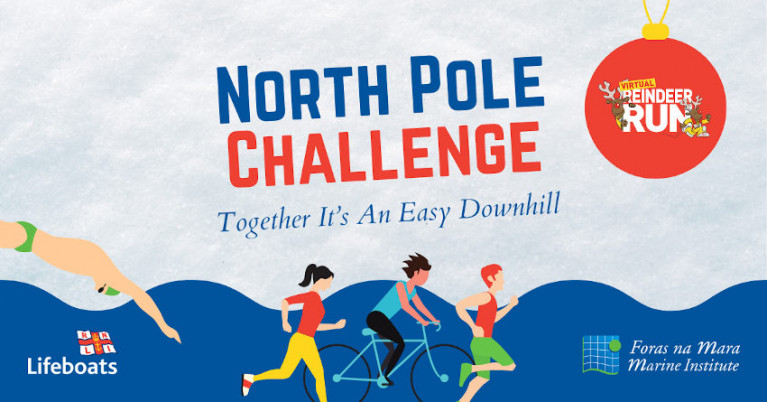Displaying items by tag: Fundraising
Right-Wing Attacks Backfire as Humanitarian Work in English Channel Drives Bumper Fundraising Year for RNLI
The RNLI has recorded a bumper year in donations driven largely by public support for its humanitarian work in the English Channel, as the Guardian reports.
Online donations to the charity that saves lives at sea have risen by 50% in 2021, it says, putting it on course for its best fundraising year since it was founded in 1824.
In July last year the charity’s chief executive issued a statement in the wake of criticism from right-wing commentators and media for its efforts in rescuing asylum seekers from the English Channel, emphasising that he “could not be prouder” of the work of the RNLI’s volunteers.
Since the tragic drawing of 27 people in the Channel in November 2021, just days after an attempted blockade against a lifeboat by fishermen allegedly encouraged by right-wing propaganda, the RNLI says its support from the public has only grown stronger.
The Guardian has more on the story HERE.
Lough Derg Lifeboat Fundraising Volunteer Receives Excellence Award
A fundraising volunteer for Lough Derg RNLI has received an award for her services to the Co Tipperary lifeboat station.
Laura Clarke was presented with the Excellence in Volunteering Award by RNLI community manager Jennifer Grey during the annual Christmas card and gift sale at Lough Derg Yacht Club in Dromineer yesterday (Tuesday 9 November).
Laura has been a volunteer on the Lough Derg RNLI Fundraising Committee for 11 years. She says she became a volunteer because the charity “was one my late father loved and always supported, and it was something I wished to continue”.
She recalled that her father Mr Crawford had donated to Portrush lifeboat station in Northern Ireland for the build of their new lifeboat. In 2019, Laura organised a fundraising swim in memory of her father that raised significant funds for the RNLI.
As well as a long family association with the lifeboats, Laura’s husband Caleb is honorary treasurer for both Lough Derg RNLI’s lifeboat station and fundraising committee, while her brother-in-law Peter Clarke was a volunteer helm with the station for 14 years.
In commending Laura for the award, RNLI director of fundraising Jayne George wrote: “Your productive, innovative and reliable attitude has not only optimised our fundraising opportunities at local events but throughout the pandemic has raised more than £2,000 in Christmas card and gift sales alone.”
Of the volunteer’s hard work throughout these difficult past two years, Jayne added that Laura’s enthusiasm and dedication “embodies the RNLI core values of being courageous, trustworthy, selfless and dependable”.
Laura said it is a “great honour to be a part of an organisation that is such a force for good in the world. I’m thrilled to receive this award.”
Niamh McCutcheon, chair of the Lough Derg RNLI fundraising branch and member of the Irish Council of the RNLI. added that she is “delighted to see Laura’s commitment, dedication and significant efforts acknowledged with this award”.
Three Larne RNLI Fundraisers Recognised for Combined 70 Years of Volunteer Service
Three members of Larne RNLI’s fundraising committee, who between them have volunteered for a combined 70 years, have been awarded with long-service medals recognising their contribution to saving lives at sea in Northern Ireland.
Pamela McAuley, Esther Dorman and Stephen Craig were presented with their medals ahead of the reopening of the lifeboat Christmas shop in the Murrayfield arcade in Larne, Co Antrim.
Recalling why she got involved with the charity, Pamela McAuley — who is the chair of Larne RNLI’s fundraising committee — said: “My family have always been keen sailors, being involved with a local sailing club.
“I thought it seemed a good way to give something back to a charity that is always ready and willing to answer every call for help at sea.”
Stephen Craig said: “I got asked to help out with a fashion show that the fundraisers put on in the autumn of 1998 and enjoyed helping out. It wasn’t until 1999 that I officially joined as a volunteer.
“I have been a lifelong sailor with a particular interest in sea safety and with prior work commitments I would have found it difficult to commit as a crew member. However, volunteering with the fundraisers was a suitable alternative.”
Esther Dorman, who is the secretary of the fundraising committee and has been volunteering for the RNLI for 30 years, added: “Like Stephen and Pam, my family has been involved with Larne RNLI now for many years, with my brother, nephew and niece all being volunteers.
“I’m happy to be involved with fundraising as I feel I’m supporting a worthwhile cause.”
Larne RNLI’s pop-up Christmas shop is back this year in the Murrayfield arcade in Larne. The shop is open every Wednesday, Friday and Saturday from 10am to 4pm.
Skerries RNLI thanked two young fundraisers when they were presented with a cheque for €150 this week.
Abi Ferguson and Niamh O’Reilly presented the volunteers at the north Co Dublin lifeboat station with the generous donation before GAA training on Thursday evening (30 September).
The two girls raised the money by holding a cake sale outside Abi’s house last month. The actual total was even higher as they raised €175.
Both girls love their GAA so to thank them for their support, Abi’s father Philip — who is a long-standing member of the crew in Skerries — organised for Dublin GAA legend and RNLI ambassador Lyndsey Davey to meet the girls and help them present the cheque.
Skerries lifeboat press officer Gerry Canning said: “It’s still a very difficult environment for fundraising at the minute so it’s an incredible achievement by two youngsters. They are two future fundraising superstars.
“We’d also like to say a huge thank you to Lyndsey for giving up her time. She was fantastic with the girls who were a little starstruck at first but were soon bombarding her with questions.”
Athlone Women Raise More Than €11k for Lough Ree RNLI in Marathon Swim
Athlone open water swimmers Serena Friel and Karen Reynolds have presented Lough Ree RNLI with a cheque for €11,300 following a fundraising swim on the lake last month.
Throughout this year the women, who have been swimming regularly at Coosan Point, admired the progress on the new boathouse for the lifeboat which is under construction on the lake shore.
When they heard of an initiative to raise a local community contribution of €100,000 for the facility, they decided to lend their support.
Under the careful eye of their coach David Warby from Athlone Regional Sports Centre. they set about the task of training to swim the length of Lough Ree — a challenging 32km from Lanesboro Bridge on the Longford/Roscommon border to the Town Bridge in Athlone.
They completed the task last month in a record time of 10 hours 13 minutes.
On Thursday last (16 September) Serena and Karen visited the Lough Ree RNLI facility at Coosan Point and presented treasurer Vincent Rafter with a cheque for €11,300 — more than 10% of the overall target.
 Karen Reynolds and Serena Friel with a lake chart of their swim route | Credit: RNLI/Tom McGuire
Karen Reynolds and Serena Friel with a lake chart of their swim route | Credit: RNLI/Tom McGuire
At the presentation, Serena thanked everyone who had supported them in the ‘Lough Ree Challenge’, especially Midland Print, Cantwell Corporate Finance, the staff of Athlone Mail Centre and clients of Serena’s Hair Studio.
Karen thanked “everyone who had contributed to the fund and especially logistics coordinator Carmel Hughes and Catriona Cantwell for social media”.
Accepting the generous donation, Vincent Rafter said: “Both women have made an invaluable contribution to the charity and to water safety on the lake and River Shannon.”
So far this year Lough Ree RNLI has responded to 42 callouts to people and vessels in difficulty on the water.
This week Lough Ree RNLI also received a generous contribution to the fund of €1,500 from RBK Chartered Accountants.
The station has a local bank account where all donations, large or small, are welcome. The account name is Loughree RNLI Boathouse Appeal, the BIC is AIBKIE2D and the IBAN is IE80AIBK93226458090098.
Portrush Athlete to Put In Mayday Miles for Local Lifeboat
Portrush athlete David McGaffin is taking the RNLI Mayday Mile challenge to a whole new level to raise funds for his local lifeboat station.
The McGaffin family has a long association with Portrush RNLI on Northern Ireland’s North Coast. David’s late father Tom was an integral part of the fabric and was one of the crew on the famous shout in 1989 when the lifeboat was launched to reports of two Spanish trawlers in difficulty.
David, a Springwell Running Club member and long-time supporter of Portrush RNLI, shared his story and why he is setting himself this gruelling challenge.
“The first marathon I took part in was Belfast on 6 May 1985 and was in aid of the RNLI. There was a lot of blistering, some bleeding and an amount of distress so the fact that the race is always held on May Day, which is also an international distress signal, is not lost on me.
”Growing up in Portrush, especially if you fish and mess about in boats, you are very aware of the work that the RNLI does and the amount of money that it takes to keep the service operating.
“My father Tom, who was a RNLI member for many years, initially as a shoreline member, then lifeboat crew and latterly as the deputy launch authority, spent many years fundraising for the RNLI and was one of the founder members of the Portrush Raft Race.
”The RNLI, especially the boat crews, can be a self-deprecating bunch and do not take praise well. To them it’s just a job they do, and once a mission is over, they get ready for the next one.
‘To complete this challenge I will have to run more miles in a month than I have ever done before and week four will be the most miles I will have ever run in a week’
“I have been fortunate to know many crew members, including some who served on the Portrush lifeboat in the 1960s. I have been on boats running for the cover of the harbour in bad weather as the lifeboat launches to someone in distress, and have stood safely on the harbour wall watching the lifeboat head out into the worst weather that the North Atlantic can deliver.
”What I do know about the RNLI is that they are ordinary people doing extraordinary things and deserving of all the medals, commendations and plaudits they receive.“
David added: ”In the absence of the Raft Race I will be taking part in the RNLI May Day Mile challenge, but taking it just a bit further.
“The challenge is simple: set an exercise goal, raise some sponsorship and then complete it. Those of you that know me will know that it’s not going to be that straightforward, there’s no point doing easy if you’re asking for money. I know that you expect some degree of pain, suffering and sacrifice to part you from your hard earned cash, and to that end I will be running the date each day. That’s one mile on the first, two on the second, three on the third and so on.
”To save you from doing the maths the first week is handy enough, week two is alright, it’s tougher going in week three, week four is insane and the last three days just mad. To complete this challenge I will have to run more miles in a month than I have ever done before and week four will be the most miles I will have ever run in a week.“
Portush RNLI press officer Judy Nelson praised David’s dedication to the lifeboat station, especially at a time when the station’s fundraising activities have been severely curtailed by the pandemic while crews have been busier than ever.
”To have someone like David who is not only running to raise funds but also raising awareness of the work our volunteers do is fantastic — we wish him all the best."
If you want to donate to David and the station you can do so via the JustGiving link HERE.
Irish Diaspora in US Donate $5,000 to Kinsale RNLI for Lifesaving Efforts
Like every other RNLI station, lifeboat volunteers at Kinsale RNLI have been unable to pursue their normal fundraising activities due to Covid-19 restrictions.
So they were surprised and delighted to receive a cheque recently for over $5,000 from a group of Irish expatriates in the USA.
McCarthy’s Bar in San Francisco — owned by Eileen McCarthy from Drinagh, West Cork — became an unlikely outpost for the lifeboat thanks to Kinsale native John Farley, who has lived in the Californian city for the past 30 years.
John is a lifelong supporter of the RNLI, with first-hand experience of their work after he, his sister and niece were rescued a number of years ago when their boat broke down off the Old Head.
Towards the end of the American NFL season, John organised a football pool with 25 friends, many from West Cork, for the final four San Francisco 49er games. They raised an incredible $5,200.
This is the largest single donation received by Kinsale RNLI since lockdown was introduced in March last, and the station says it will go a long way towards funding an essential service that has remained on call throughout the COVID-19 pandemic.
Eileen and John have now installed an official RNLI collection box in McCarthy’s bar so fundraising can continue into the future. “We all appreciate that that RNLI is there for us when we need them, so we wanted to be there for them in their hour of need,” John said.
Kinsale RNLI lifeboat press officer Tricia Tyson commented: “John has been a great supporter down the years, and tells me their next big fundraiser will be for the RNLI in the Aran Islands as one of his group, Ronan Concannon, is from Aran Mor.
“We are delighted they are sharing their generosity with hardworking stations around Ireland. Our RNLI collection box only arrived in San Francisco a few weeks ago and John tells me it is almost full already.
“On behalf of all our RNLI volunteers, I wish to sincerely thank John, Eileen and all the McCarthy’s bar customers for remembering the RNLI back home. It just goes to prove the old adage that you can take a man out of Ireland, but you can’t take Ireland out of the man.”
The other Kinsale fundraisers in San Francisco are Fergus O’Shea, Derek Lovell, Polo Crosbie, Jason Davenport, Richard O’Keeffe, with John Farley and Kathleen Barry in Boston, Gertie O’Shea in Vancouver and the Callanan family, related to John Farley, who live in Kinsale.
Galway Corinthians RFC Raise Over €8,500 for Galway RNLI & Cancer Care West
What started as a small fundraiser for Galway RNLI and Cancer Care West has turned into something spectacular as the players and members of Galway Corinthians RFC have raised over €8,500 for both organisations through two fundraising efforts.
The first featured the senior players in the club with Jack Noone and Kenneth Casburn behind the organisation of ‘Movember’ where players, management and committee members grew facial hair of some kind for the month of November.
The second featured the mercurial talents of club president Kieran Faherty.
Known fondly as ‘Flash’, Kieran is an accomplished artist and he generously provided one of his paintings known as ‘Brewing Up A Storm’, a stunning view of Galway Bay that has proved very popular with prints and cards selling out quickly.
But what inspired the painting? “I am often asked that,” Kieran says. “Pretty much my signature pieces are all about colour, and Connemara is my inspiration for many.
“As a kid I only saw greyness in the Connemara landscape, but age opens your eyes. Now I embrace all the wonderful changing coloured landscape that the mountains, bogs and lakes give up to us.”
He added: “I think my inspiration for this piece is the challenges it offers, as it sits in stormy waters, and I think appropriately it is raising funds for a charity that lives in stormy waters with their incredible brave crew.”
The fundraising has been warmly welcomed by both organisations, with Mike Swan, Galway RNLI lifeboat operations manager, saying: “I wanted to express my personal gratitude for the effort of the members of Corinthians Rugby Club and thank them for their very generous donation, of which will be put to good use saving lives at sea.
“Given the year that’s in it, the crew are overwhelmed with the support from the people of Galway.”
The families of RNLI lifeboat volunteers have joined an all-Ireland appeal for support after the charity’s usual Christmas fundraisers were cancelled.
As previously reported on Afloat.ie, the charity that saves lives at sea launched its 2020 Christmas appeal as so many traditional community fundraising events such as raft races, open days and sea swims have had to be called off due to coronavirus restrictions.
In Donegal, Lorraine Cassidy’s husband James and sons Nathan (22) and Oisin (21) are all volunteer crew members on Bundoran RNLI’s inshore lifeboat. They know all too well how important it is for crews to have the right lifesaving kit and PPE.
Nathan adds: “RNLI volunteers have had a challenging year but thankfully, with many additional safety measures and procedures in place to ensure our safety, we have remained on call 24/7 throughout the pandemic.
“We have our standard PPE but now also wear masks and gloves and take extra precautions at sea. We know the extra PPE comes at a financial cost to the charity and during a time when fundraising activity has had to be halted.”
Further south are Robert and Colette Foster, whose daughter Caoimhe (20) is a volunteer crew member on Crosshaven RNLI’s inshore lifeboat.
“We are very proud that Caoimhe has been a volunteer lifeboat crew member in Crosshaven for three years now,” her father Robert says. “Our son Cillian (17) is also joining the crew but due to Covid-19, won’t be starting his training until next year.
“Our youngest Clodagh is 12 and having watched Caoimhe’s involvement in the last few years, she is already aspiring to be part of the future crew.”
In East Cork, Mark Nolan has been a volunteer at Youghal RNLI for 23 years, first as a crew member on the station’s inshore lifeboat where he served for 13 years before moving to shore crew. In 2017 he became a deputy launching authority where, among his tasks, he authorises the launch of the station’s lifeboat when the alarm is raised.
Mark’s son Jack (22) followed in his father’s footsteps five years ago when he, too, joined the lifesaving team in Youghal.
“You worry when the pager beeps and you are responsible for authorising the launch of the lifeboat,” Mark says. “While Jack is my son, I would have similar concerns for all crew members who go out on the lifeboat to save others who are in trouble at sea.”
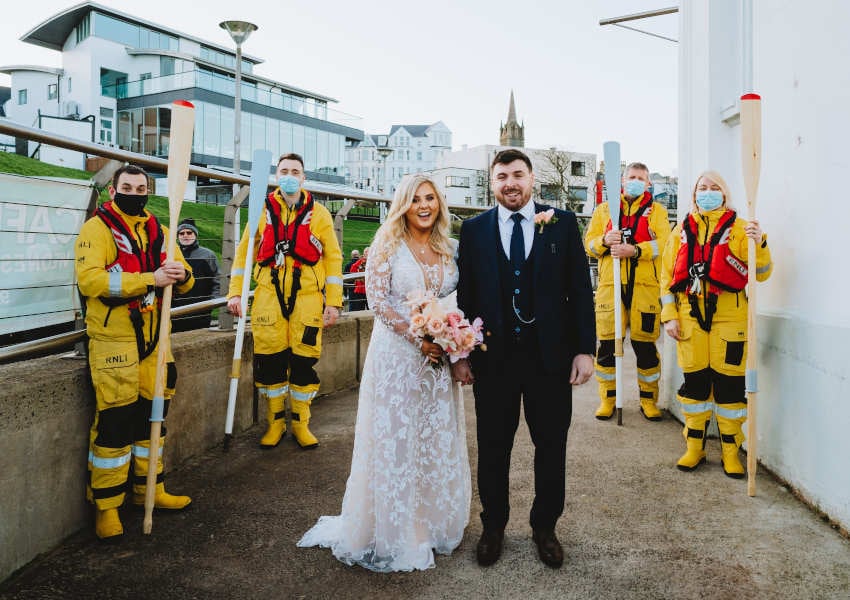 Jason Chambers and his wife Lauren received a special guard of honour from Portrush RNLI after their wedding last week | Photo: Mairéad McDaid/Remain In Light Photography
Jason Chambers and his wife Lauren received a special guard of honour from Portrush RNLI after their wedding last week | Photo: Mairéad McDaid/Remain In Light Photography
For Portrush RNLI relief mechanic Jason Chambers and his wife Lauren (McGee), who is a professional wedding photographer, 2020 has been a year like no other.
The couple who have two children, Tyler (9) and Isla (5), were originally due to get married on 18 April but when Covid-19 restrictions came in shortly after they returned from their hen and stag parties, they were forced to postpone and rethink their plans.
A stressful few months later and amid restrictions changing regularly, the couple eventually got their big day last week.
And much to Jason’s surprise and delight, four fully kitted-out lifeboat crew members representing the station were waiting outside the Arcadia in Portrush following the ceremony to provide a socially distant guard of honour to wish the couple well.
Lauren is also well used to family events being interrupted by the pager. And this Christmas will be no different for the Chambers.
“From the moment I met Jason, the RNLI pager became a part of my life, too. The lifeboat has always been in Jason’s blood and he comes from a long family line who have been involved in helping to save lives at sea for generations.
“It can be difficult seeing Jason leave when the pager goes, and he heads for the lifeboat. I worry about what he might go through when he is out on a shout. Even at Christmas, we know that he might have to drop everything like the other volunteers in Portrush, Red Bay or Larne and run out the door to go and save someone’s life.”
The same goes for Sue and Peter Irwin, longtime volunteers with Donaghadee RNLI, whose son Jack is a volunteer on Bangor RNLI’s inshore lifeboat.
“However, I also know how important the crew member’s role is and how rewarding it is for Jack to make his contribution just as it was for Peter and is for me as a fundraiser,” Sue says.
“The RNLI depends on the goodwill of others to support the work our volunteer crews do and that is why as a family, we would urge people if they can, to give to the Christmas appeal.”
Meanwhile, for one teenager who has helped out where he can at Kilkeel RNLI since he was a child, this year Christmas will be extra special as he will finally be eligible to join the crew on his 17th birthday on Christmas Eve.
Andrew Young’s father Gary has been a RNLI volunteer for the last 32 years. Watching his father work as station mechanic and helm, Andrew was inspired to become a crew member at a young age and is now looking forward to making his own contribution.
“I have been coming to the station with Dad for years and I always loved watching the crew prepare and train between call outs,” Andrew said. “I have helped out where I can but I am really excited now to start my own training to become a crew member and I will look forward to the day that I, too, can help bring someone in difficulty to safety.”
All families share pride in their loved ones’ lifesaving efforts, but they also worry when the pager beeps and they’re called out to save others who are in trouble.
The sense of relief when they help to bring those in difficulty back to safety, but also when they return home safety themselves, is one that they all feel.
And they’re united in declaring that the best Christmas gift they can wish for is any kind of donation, no matter how small, to the RNLI Christmas appeal.
Funds raised will provide the lifesaving kit volunteers so need to continue to help saving lives at sea. For more visit RNLI.org/Xmas
Join in with Marine Institute Staff on Virtual Festive North Pole Trek in Aid of RNLI
Staff at the Marine Institute are attempting to walk, run, row, cycle and swim the 4,068km distance from their headquarters in Galway to the North Pole in aid of the RNLI.
And they’re inviting everyone to join in and support their virtual festive fundraising challenge, which runs until Friday 18 December.
“Many of our colleagues and those that we work with spend much of their time at sea,” says Marine Institute chief executive Dr Paul Connolly. “Knowing that the emergency services are there should we need them is a huge comfort for all who use the ocean whether for work or for pleasure.
“This year has been difficult for many and especially hard also for charities such as RNLI Lifeboats Ireland. For these reasons, as an organisation the Marine Institute decided that together we could do our bit to support the RNLI and have a bit of festive fun while we are at it.”
It costs the RNLI €1,650 to train a volunteer lifeboat crew member for a year, and €1,764 to kit them out in their lifesaving gear — so every euro raised counts.
“We are asking the public to consider adding their kilometres to our fundraiser and making their steps or swims count. Together we can make this an easy downhill and raise much needed funds for RNLI lifeboats,” Dr Connolly adds.
If you want to take part, commit some kilometres to the 4,000km total or choose to donate. And don’t forget to post your challenge photos on social media, tagging the Marine Institute on Twitter or Facebook and using the hashtag #NorthPoleChallenge


























